 |

| |
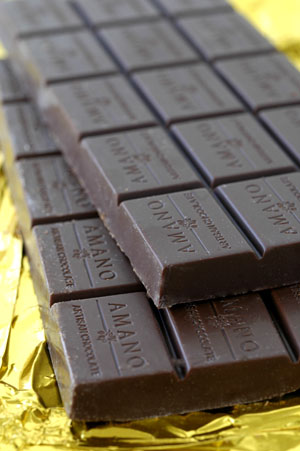
Two of Amano’s single origin chocolate bars from Venezuela: the fruity Ocumare and the spicy Cuyagua. Photo by Dhanraj Emanuel. |
| WHAT IT IS: Single origin chocolate bars, hand-crafted by artisans in a bean-to-bar facility in Utah. |
| WHY IT’S DIFFERENT: Artisan dedication to finding the best beans (trekking through remote plantations in third world countries) and shipping them back home to roast and grind into chocolate. |
| WHY WE LOVE IT: With a focus on just two or three bars, they can focus on doing it well. |
| WHERE TO BUY IT: AmanoChocolate.com. |
|
|
 |

Amo, Amas, Amat:
Amano Artisan Chocolate
CAPSULE REPORT: It takes passion, skill and guts to open a bean-to-bar* chocolate factory with the goal of nationwide distribution. In this country, aside from large industrial producers, only three artisan companies have done so. The first two were Scharffen Berger, spearheaded by an entrepreneur who had launched and sold a successful Napa Valley winery to the owners of Pommery Champagne; and Seattle’s Theo Chocolate, begun by an experienced importer of cacao beans. Now, high in the Rockies, in Utah’s Wasatch Mountain range, two young men with no prior food experience are the third. Amano Artisan Chocolate is dedicated to creating some of the world’s finest chocolate bars. Most people who have dreamed of quitting their day jobs to make great chocolate would find the challenge daunting, the odds against success stacked as high as the Rocky Mountains. But, undaunted, Amano succeeded in its debut year, winning three gold medals at the 2007 San Francisco Chocolate Salon and a finalist trophy for Outstanding New Product at the Fancy Food Show.
*A company that buys raw cacao beans, roasts them and creates their own couverture chocolate, from which all chocolate products are made. Most sellers of fine chocolate purchase their couverture from the few dozen companies worldwide that make it. See our article on couverture.
In Italian, Amano means both “by hand” and “they love”†. It’s an appropriate name for a chocolate crafted by hand with love. The chocolate not only tastes great, it’s packaged beautifully for gift-giving, and it’s affordable enough to be a stocking stuffer for everyone you know who loves fine chocolate (tip: grab the limited edition Cuyagua bars). Read the full review below.
†But not in Latin, from which we borrowed our headline. “They love” would be amant: amo, amas, amat, amamus, amatis, amant.
- Read reviews of more of our favorite gourmet chocolates in THE NIBBLE online magazine.
- See the Table of Contents of the October issue of THE NIBBLE, plus the prior issues archive and our most popular articles.
- All of the Top Pick Of The Week newsletters are permanently archived in chronological order and by product category.
|
THE NIBBLE does not sell the foods we review
or receive fees from manufacturers for recommending them.
Our recommendations are based purely on our opinion, after tasting thousands of products each year, that they represent the best in their respective categories. |
More Great Chocolate
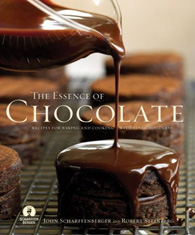 |
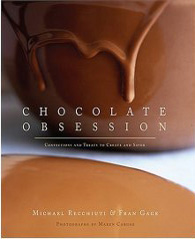 |
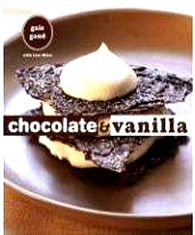 |
| Essence of Chocolate: Recipes for Baking and Cooking with Fine Chocolate, by John Scharffenberger and Robert Steinberg. America’s preeminent maker of gourmet baking chocolate launches its first cookbook, with more than 100 recipes for classics as well as Chocolate Chunk Challah, a homemade version of Oreos and savory dishes made with chocolate like Tortilla Soup and Chile-Marinated Flank Steak. Click here for more information. |
Chocolate Obsession: Confections and Treats to Create and Savor, by Michael Recchiuti and Fran Gage. The top chocolatier makes it possible for amateurs to achieve his artistry in dipped chocolates, truffles and molded chocolates. With his recipes for Earl Grey tea, burnt caramel and tarragon with grapefruit ganaches, plus some delicious baked goods (Recchiuti is also a pâtissier), this book provides many hours of happiness. Click here for more information. |
Chocolate and Vanilla, by Gale Gand. James Beard Award-winner Gand, host of the Food Network’s Sweet Dreams and co-owner and Executive Pastry Chef at Chicago’s Tru, dazzles as usual. Recipes are both delicious and visually arresting. Those who are chocoholics may discover their inner vanilla-holic in this book, which gives equal attention to the spice that Gand considers even sexier than chocolate. Click here for more information. |
Amano Chocolate: Amo, Amas, Amat, Amano
INDEX OF REVIEW
|
MORE TO DISCOVER
|
Spilling The Beans About Fine Chocolate
In the world of chocolate bars, there are generally three types available to consumers: mass-produced, the so-called “artisan” barsand a middle approach, the “mass marketed prestige” bars that bridge the gap between the two. Let’s talk about mass-produced bars first. They’re the first ones we had as kids (unless you grew up in a rarified environment, the child of chocolate connoisseurs who fed you only kiddie Richart and Belgian Godiva). They are churned out by large corporations (Cadbury, Hershey, Nestlé and brands well-known in Europe, Freia, Milka and Ritter). The cacao beans that are used in these bars are low grade and inexpensive, usually of the Forastero variety, one of the three species of cacao beans, along with the fine-grade Criollo and Trinitario. (See our Chocolate Glossary for an explanation of all things chocolate.)
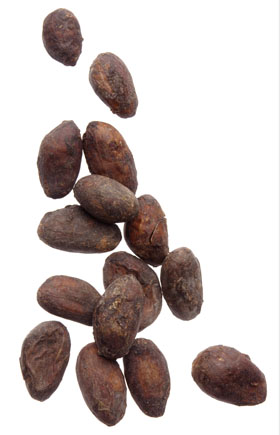
“The good stuff”: Criollo cacao beans.
|
Forastero Cacao Beans
Forasteros are what are referred to as “bulk beans” and account for 80% to 90% of world cacao production. These are the beans used in mass-produced bars. The plants are a farmer’s dream: They are easy to grow, with a hearty resistance to disease, incredible tolerance to the environment and prolific production. Any cacao grower who wants a secure and stable price on the world market grows Forastero. They are a manufacturer’s dream, too: plentiful and cheap.
But they’re not a fine chocolatier’s dream, nor a connoisseur’s. Their inherent flavor is not complex but very basic. Forastero beans may contain off-notes, bitterness, mold and other unpleasant characteristics that collectively detract from the quality of the finished chocolate. Because the beans can be extraordinarily bitter, they require a longer fermentation time. However, any irregularities in flavor and bean quality can usually be smothered simply by adding more beans and/or sugar (and milk, for milk chocolate). As a result, manufacturers can get away with using less-than-ideal beans, and folks who love their newsstand candy bars don’t know the difference. In the end, Forasteros supply a simple but deep, rich chocolaty flavor turned into sweet candy bars beloved by everyone who picks them up at the newsstand, supermarket or drug store. Prices for these bars are usually $2.00 or less.
|
There are some good Forastero beans out there, and artisan producers, who make the finest chocolate, use them, sometimes. Forastero beans are called for when a strong, chocolaty backbone is needed for blended bars.† A few varieties of Forastero actually possess such great flavor that they can be featured in a single origin bar. For example, Pralus makes several excellent Forastero bars (sourced from Brazil, São Tomé and Tanzania) as do Theo (Ghana and Ivory Coast), Neuhaus (West Africa) and Divine (Ghana).
†Bars made from the beans of many different regions and countries, as opposed to single origin bars.
Ecuador’s Arriba Nacional‡ cacao is a unique Forastero that has all the delicacy of a top “flavor cacao” (more about that in a moment), and Colombia’s Nacional is another fine Forastero with exceptional finesse of flavor. Quite a few top chocolate companies produce Arriba bars. Among the best are Dagoba (Los Rios), Felchlin and Slitti (Tropicale). As for Colombian Nacional, Santander is the obvious choice since all of its bars are produced from these beans. And some origins, like the island republic of São Tomé off the west coast of Africa, produce remarkable Forastero cacao with exciting smoky notes that is in demand by top chocolatiers as a single origin chocolate.
‡ Some call it Arriba, some call it Nacional and some call it Arriba Nacional. Arriba means “up river,” which is where the plantations are, where you have to go to get the beans. Nacional, national, refers to the “national” cacao bean of Ecuador, where this bean mutation originated.
Flavor Cacao: Criollo & Trinitario Beans
When artisan producers make chocolate bars, they emphasize single origin cacaos or blends that utilize high-quality beans to achieve a complex and multifaceted flavor. For these purposes, “flavor cacao” is needed. Flavor cacao refers to the Criollo and Trinitario varieties, which are complex in flavor and delicate in overall nature. They are normally less bitter than Forasteros and impart greater dimensions to a chocolate bar.
The delicate Criollo, considered to be the finest cacao, accounts for 2% to 5% of world production, while Trinitario, an accidental crossbreeding of Criollo and Forastero dating back to the 1700s, is responsible for 8% to 12%. Part of the reason for these low percentages is that both bean types are more susceptible to diseases and changes in the weather (though Trinitarios are more hearty than Criollos due to their half-Forastero parentage). Yield is therefore lower, and the trees require more attention and care from the farmers. All these factors translate to rarity and higher prices on the world market.
|
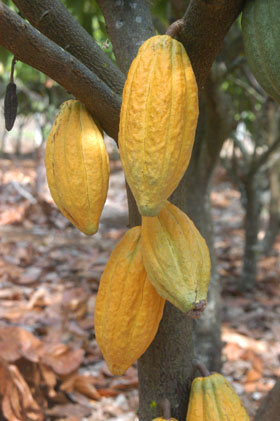
Criollo cacao tree. There’s no way to tell whether it’s a Criollo, Forastero or Trinitario tree based on the color of the cabosses (pods). |
The bars made from these beans are usually produced in smaller numbers, and, quite often, in limited editions if bean supply is exceedingly low. Pierre Marcolini and Scharffen Berger have produced limited edition bars from rare beans, as has Amano. “Limited Edition” isn’t a marketing ploy. It means that there aren’t enough beans to warehouse for future batches, and the small crop has an unusual flavor that can’t be guaranteed to be duplicated in next season’s crop—assuming the beans are available at all. Hence, only a limited number of bars that taste like this can ever be produced, so “enjoy it while it’s here.”
Companies such as Amedei, Guittard, Michel Cluizel, Pralus and even Valrhona are considered artisan. Prices for chocolate bars from these companies typically start at around $5.00 and can exceed $10.00, depending on size, bean type and rarity, and origin. Valrhona is the odd man in this group: It has achieved a relatively large size and worldwide distribution, although it still pales in comparison to the production of Lindt or Hershey. Questions of quality always arise when a company increases in size. A tricky balancing act is required to avoid a potentially damaging conflict of interests between quality and output. Valrhona has never lost its high-caliber footing, showing other artisan producers that it can be done.
Mass-Marketed Prestige Chocolate
Mass-marketed prestige chocolates might sound like an oxymoron, but upon closer examination, it isn’t. Increasingly, with the growing interest in better chocolate, an industrial company such as Hershey or Lindt, which sells mass-produced chocolate bars, will create an additional line that bridges the gap between artisan and mass-produced bars. These bars are made with finer cacao than the companies’ main lines, but the quality will never be as top notch as what the artisan producers use. These “bridge” chocolates have finer flavors than the bars of their main lines, and the price is very reasonable as well.
The Cacao Reserve by Hershey’s line and Lindt’s Excellence line are prime examples of mass-marketed prestige chocolate. Cote d’Or, Ghirardelli and more recently, Chocolat Frey have readily available lines as well; and at a general price that sits between $2.00 and $4.00, you can’t go wrong. You don’t have to find an exclusive chocolate shop: The bars can generally be found at supermarkets, grocery stores, corner markets or any other commercial outlet that stocks conventional candy (Chocolat Frey is currently found exclusively at Target).
Quite often these bars are single origin in nature, but blended options are available as well. With the ongoing buzz about dark chocolate’s health benefits, and the chocolate spotlight on single origin cacaos, industrial companies are finding inexpensive sources for better-quality “mass-marketed prestige” cacao to fulfill increasing interest. For anyone curious to explore artisan chocolates, but not quite ready to take the financial plunge, this is a great place to start.
Amano: New Bars On The Block
But when faced with a good experience for $3.00 or a great one for $6.95, we say, go for the great. That’s what Amano Artisan Chocolates provides, to people who enjoy serious chocolate. We say “serious chocolate,” because we acknowledge that most people prefer the simpler, less demanding flavors in their food, the same way it’s more pleasurable for most people to drink Robert Mondavi than Cheval Blanc.
Artisan chocolate producers have typically been located in Europe: Amedei, Michel Cluizel, Pralus and Valrhona are revered bean-to-bar producers, meaning that they purchase raw cacao beans, roast them and create their own couverture chocolate, from which they make bars and, often, other types of chocolate. You can count the artisan American producers on one hand, and they include Guittard, Scharffen Berger and Theo. The newcomer choco-evangelist that’s helping to secure America’s position as a serious producer of top bean-to-bar chocolate is Amano Artisan Chocolate.
Utah might be one of the last places you’d expect to find a premium chocolate company, especially in Orem, 40 miles from Salt Lake City, which has been dubbed “The Family City” and is home to several computer corporations. But, nestled unassumingly near a high school, Amano can be found in full production.
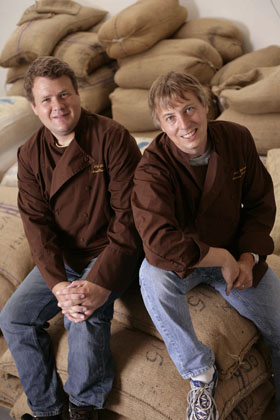
Amano founders Clark Goble and Art Pollard,
sitting atop bags of their precious single origin cacao
beans.
|
Since the news broke a few years ago that a new bean-to-bar company was being built in America, we have been following the progress of Art Pollard and Clark Goble in establishing Amano. Art, a chocolate connoisseur, wanted something different than what he was able to buy. He had been toying with the idea of producing chocolate for a while, but it wasn’t until he finally made his first crude batch of Ocumare bars that we realized he meant business (literally). Those first bars displayed great potential; Art received positive reviews not only from local chefs but from other connoisseurs who sampled them. His business partner, Clark Goble, suggested that Art take his chocolate to a much wider audience—the general public.
Art’s background in the sciences and technology was helpful in building the business (he is the owner of Lextek International, a supplier of advanced information retrieval and natural language processing technology). With a keen understanding of physics and machinery, he has constructed and modified his equipment to fit his needs. His winnower, for example, was built entirely from scratch, and he is still tweaking the machine. The mélangeur, which he imported from Europe, employs a heating mechanism which he assembled by hand, designing the electronic control system and rebuilding the entire drive mechanism in the process. Indeed, the translation of the company’s name which means “by the hand” in Italian, isn’t just about hand-crafting the chocolate.
|
But in order to make great chocolate, it’s important to understand more than just the mechanical aspects of its production. Art has traveled extensively throughout the Americas to gain a firsthand perception of how cacao is grown and processed. Through his travels, he developed relationships with farmers and traders. It is standard procedure in the industry to source cacao from brokers. If a broker has a truly magnificent bean, Amano would not turn it down. But he constantly visits individual farmers directly, trying to locate rare and unique beans. If farmers can deliver the goods, Art will gladly buy them. For example, a trip to Mexico landed the company rare Porcelana beans, which Art states will soon be put to good use. (Connoisseur hearts reading this have begun to pound at the thought of another rare Porcelana bar on the market.)
This type of sourcing inevitably leads to fluctuation in the company’s chocolate bar lineup. Larger corporations have the finances to secure ownership of greater amounts of beans, which results in a fairly consistent roster of chocolate bars. Smaller-scale producers quite often must deal in smaller quantities of a specific cacao, and can run out of their smaller production runs. One strategy would be to blend various cacaos to achieve a steady range of blended bars. However, buyers of artisan bars often prefer single origin bars, made exclusively from just one type of bean. Production will be limited, unless a certain region or plantation can steadily supply beans. Obtaining enough beans from several plantations, or through one particularly bountiful plantation, is another reason for extensive traveling.
During my visit to Amano’s factory, we could hear the mélangeur (the machine that grinds the roasted beans into chocolate liquor) noisily churning in the background. On one end of the factory, piles of beans are neatly stacked and separated according to origin. Ghana, Madagascar and Venezuela are among the origins we read on the bags, but Art led us to his current project. In the mélangeur, he was churning a batch of pure Cuyagua cocoa liquor he intends to sell in limited edition bars. Cuyagua is a region in Venezuela renowned for its distinct cacao, just like Ocumare or Maracaibo. However, it is not uncommon for plantations to combine their beans with those from another plantation in a nearby region. Art reassured us, though, the unsweetened chocolate liquor we tasted was 100% Cuyagua, and it was made into the bar described below. |
|
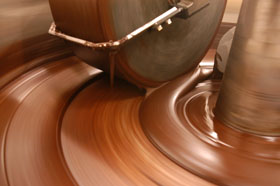
The mélangeur grinds beans into chocolate liquor,
which has nothing to do with alcohol. It is a thick,
gritty, dark brown paste obtained by grinding the nibs. Chocolate liquor is about half cocoa butter and half cocoa solids. |
Amano: The First Efforts
Amano’s first efforts are 70% cacao single origin bars, each highly distinct. Although the selection is somewhat narrow right now, Amano plans to feature more bars in the future, as its constant search for top-quality cacao yields enough beans to add bars to the “permanent collection,” as well as limited-edition bars.
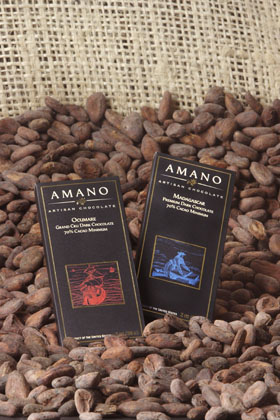
The bars are made with a dark roast.
|
From these two bars, it’s reasonable to assume that Amano prefers a slightly darker approach to roasting.** Though the caramelized undertones and darker nature of the flavor surely suggest this, Amano made sure to leave the fruitiness of each cacao a prominent player in the final flavor. In fact, earlier batches of Ocumare were roasted lighter, and a tasting between the lighter and darker roasts was revealing. The flavor produced by the lighter roast was highly fruity and light, whereas the darker roast resulted in the bolder, slightly caramelized nature. There’s no doubt Amano has a sharp eye for balance.
**Cluizel, Domori and Guittard use a similar roast. The extreme of dark roasting would be Pralus, while the polar opposite would be Scharffen Berger, and Valrhona, to a degree.
In fact, at the first San Francisco International Chocolate Salon this year, Amano was awarded gold medals in three different categories: Best Dark Chocolate, Best Dark Chocolate Bar and Most Gifted Chocolatier. These accolades are significant, especially when the company placed above such stiff competition as Terra Nostra, Theo Chocolate, and England’s highly-regarded L’artisan du Chocolat. Amano was also one of 12 finalists among 460 entries to receive silver trophies for Outstanding New Product at the 2007 NASFT Summer Fancy Food Show. |
For a startup chocolate company, such praise is no doubt encouraging. In a recent conversation, Art said he was processing Ghanaian cacao. I was able to sample some crude mass a few months ago during its experimental phase, and the results from even this unrefined clump were nothing short of stunning. Blueberries and bananas, with a deep chocolate undertone were the defining hallmarks, clearly a promising start. One can only imagine what the finished bars will taste like. If Amano’s debut offerings are any indicator (and they should be), prepare for some seriously good chocolate, and a highly successful future.
The Current Selection Of Amano Artisan Chocolate Bars
Ocumare “Grand Cru” Chocolate Bar
The beans used to produce this bar come from the Ocumare de la Costa valley, hence the designation of “Grand Cru,” a term borrowed from wine-making, meaning that the beans were sourced from only one region rather than from several surrounding areas. In the 1940s, varieties of Ocumare trees were hybridized several times, but the most desirable type to turn up was the 61 variety. The number simply refers to how many hybridizations occurred before arriving at that certain variety (i.e., 60 different hybrids were created before Ocumare 61 was deemed desirable).
Ocumare 61 is the preferred variety because it is a vigorous and flavorful hybrid. This is the predominant type of Ocumare used by El Rey in its San Joaquín Estate, and the results have been astonishing, as evidenced by the vast range of bars. Ocumare 61 is highly fruity, delivering cherries, plums and other red fruits, often with dairy notes and earthy counters in the finish. Another variety, Ocumare 67, is also grown but not as popular. It is much nuttier and not as intensely fruity.
|
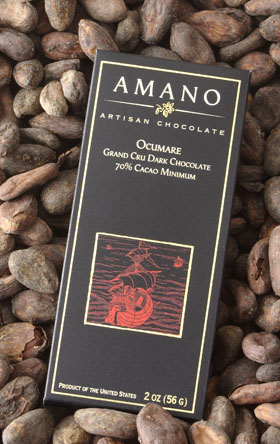
Ocumare, a hybrid of Criollo and Trinitario beans from Venezuela, is dark and bold with red fruit notes.
|
Often, farmers are unaware of which types of beans they grow, and their crops are usually a mix of different varieties, including Forasteros, Trinitario and Criollo. As a result, there may not be an identifiable variety dominating the bean blend, but there are commonalities among different chocolates produced from those beans. Amano’s interpretation of Ocumare is probably a reflection of this variability, but it certainly seems to contain key traits from the 61 hybrid. The chocolate is dark and bold, conveying red cherries and currants at pretty much any time in the profile, but there’s also a slightly caramelized twist as well that further advances a sense of darkness the bar inherently possesses. The finish is where things pick up, though, as the chocolate is decidedly earthier but not overly so. The end result is a bar that delivers the characteristic flavors of the origin—not groundbreaking or unusual, but another great variation on the Ocumare theme.
Madagascar Premium Chocolate Bar
Amano’s Madagascar bar is not a Grand Cru because the cacao was sourced from more than one region. Madagascan cacao is often vibrant with a crisp citrus acidity, but grape, pineapple, raspberry and even cranberry notes are common as well. Alcohol notes, interpreted as vodka and white wine, sometimes accompany these flavors. Spice, cedar and other woody notes are appearing in more Madagascan chocolate nowadays, thus providing a larger rainbow of flavors. Although the cacao is generally light on the palate and contains no bitterness, it is not uncommon to taste deeper chocolates with considerable heft behind the flavor. Malagasy’s Sambirano and Bonnat’s Madagascar bars are perfect examples of this tendency.
But just when you thought you knew Madagascar well, Amano offers new insight on this oft-attempted origin. The first thing you’ll notice when you unwrap the bar is the aroma. It has a wild energy that packs a balsamic wallop you’ll never forget. Tasting then reveals the same intensity of the aroma but also a wonderful and intriguing profile that includes prunes, raisins, oranges and raspberries. This is definitely a high-strung chocolate, one that’s intensely tart yet highly fruity and caramelized at the same time. One feels Amano prefers a slightly darker roast, which is most evident in this bar’s flavor and the contrast it provides to the fruitiness. You won’t easily forget this bar, that’s for sure. |
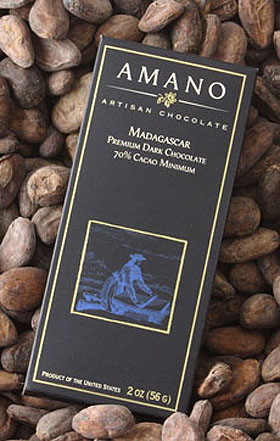
The beans from Madagascar make a chocolate that is fruity and caramelized at the same time.
|
The Cuyagua Chocolate Bar (Limited Edition)
Cuyagua is a remote valley that neighbors Ocumare de la Costa. Historically, beans from this area have been rare and not plentiful enough for companies to produce chocolate regularly. Scharffen Berger has created two limited edition batches of Cuyagua bars; to our knowledge, no one else has done so until Amano got its hands on some beans.
Due to Cuyagua’s close proximity to Ocumare de la Costa, some similarity is inevitable, but Cuyagua maintains a unique personality. Amano’s version has a medium body and complex flavor with a lot going on at all times. It’s predominantly spicy and piquant like molasses, with other notes of dairy, light red fruits, nuts, earthiness and a very slight acidity for added depth. Some raisin peeks in as well, showing that roast Amano loves and contributing more flavor to an already complex profile.
Since Scharffen Berger’s Cuyagua is the other known bar of this type, our basis of comparison and our knowledge of this cacao is small. But from what Amano shows us, the hype that has centered on this cacao since the 1700s is more than justified. Amano has done a wonderful job here, and, in fact, with everything they have put out so far. |
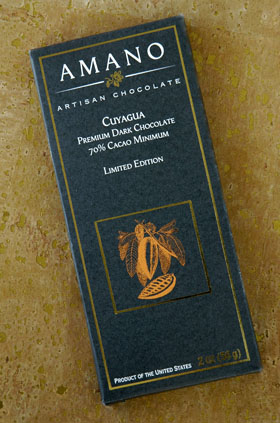
Few people have ever had a Cuyagua bar. The beans are hard to come by, and that’s why this bar is a limited edition. Our editor loved all three, but this was her favorite—and ours, too.
|
If your passion is for great chocolate bars...if you know what it’s like to yearn for a great single origin bar from Michel Cluizel or Valrhona...get to know the bars from Amano. In cacao veritas.
— Peter Rot
FORWARD THIS NIBBLE to anyone who love fine chocolate.
AMANO ARTISAN CHOCOLATE
Artisan Chocolate Bars: Cuyagua (Limited Edition), Madagascar and Ocumare; Additional
Bars Forthcoming
- 2-Ounce Bar
$6.95
- 10 Bars, One Variety
$62.95 (10% Discount)
Buy online at AmanoChocolate.com
Prices and product availability are verified at publication but are subject to change.
Back to Index |
 |
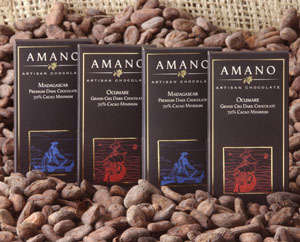
|
Read more about our favorite
chocolates and related products:
|
Check Out These Other “Top Pick Of The Week” Bars:
|
Do you have friends who would enjoy THE NIBBLE?
Click here to send them an invitation for the Top Pick Of The Week newsletter. |
ABOUT THE NIBBLE. THE NIBBLE™, Great Food Finds™, is an online magazine plus newsletters about specialty foods and the gourmet life. It is the only consumer publication and website that focuses on reviewing the best specialty foods and beverages, in every category. The magazine also covers tabletop items, gourmet housewares, and other areas of interest to people who love fine food.
© Copyright 2004-2026 Lifestyle Direct, Inc. All rights
reserved. All information contained herein is subject to change at any time
without notice. All details must be directly confirmed with manufacturers, service
establishments and other third parties. The material in this e-zine may not
be reproduced, distributed, transmitted, cached, or otherwise used, except with
the prior written permission of Lifestyle Direct, Inc.
|
 |
|
 |















